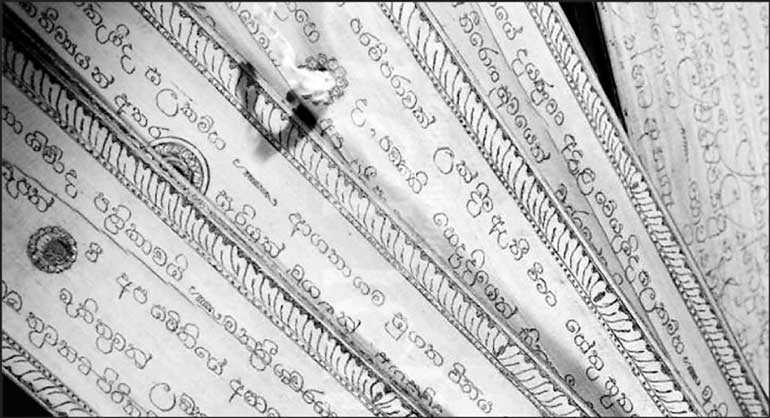Wednesday Jan 21, 2026
Wednesday Jan 21, 2026
Saturday, 5 January 2019 00:00 - - {{hitsCtrl.values.hits}}

By Sugeeswara Senadhira
The most important gift Sri Lanka ever received from overseas, the message of the Gauthama Buddha has introduced a unique religious philosophy together with a new culture and a way of life to the people of this country.
The teachings of the Buddha or the Thervada Tripitaka was introduced by Arahath Mahinda in Pali language and it was brought forward by word of mouth for generations until it was transcribed into written text on Ola leaves in the 1st Century at Aluviharaya in Matale.
In a significant move to provide the long due proper status to the Tripitaka, it is to be proclaimed as a national heritage by President Maithripala Sirisena today (5).
The Pali Tripitaka volumes considered as the foundation source of the Sri Lankan Buddhist tradition. Tripitaka Dharma constitutes of the Sutra Pitaka, Vinaya Pitaka, and the Abhidharma Pitaka as well as the Atthakatha and Teeka.
This is one of the most prominent sacred religious heritages in the world history which was brought forward for generations by listening to verbal recitations and memorizing. From the first Dhamma Sangayana (First Buddhist Council) to the transcription of the Tripitaka at the Matale Alu Viharaya in 1st Century A.D, the Maha Theras and their student generation preserved this Dharma through oral form.
The Buddha’s teachings were divided into nine parts during his lifetime and during the first Dhamma Sangayana it was divided into three parts as Sutra Pitaka, Vinaya Pitaka, and the Abhidharma Pitaka. The Dhamma preached by the Buddha for over 45 years was preached by 500 bhikkhus jointly by memorizing those teachings, at this first Dhamma Sangayana. Since then the great responsibility of preserving this Vinaya Pitaka for the benefit of the Sasanaya was vested on Ven. Upali Maha Thera and his student generation.
There are some controversial points regarding Theravada Tripitaka. According to Bertram G. Liyanage of the Editorial Team of the Encyclopaedia of Buddhism, one of the issues is whether Theravada Tripitaka is the most accurate and original words of the Buddha.
The Buddha once admonished to study his teachings in ‘one’s own dialect’ (sakaya niruttiya). The Pali term in this context can be interpreted in two ways. First, it says ‘in the language of the Buddha’ and secondly ‘in the language of oneself (the hearer).
At the very outset, Sri Lankan Theravada tradition seems to agree with the first interpretation ubiquitously. This agreement led them to infer logically that Arahant Mahinda Thera introduced Tripitaka to Sri Lanka by the language of the Buddha, Pali. Subsequently, Pali language was further promoted by adopting the concept of mulabhasa, which introduces the Pali as original or natural human language.
Although there is an acceptance by many that Buddha spoke Magadha, even today, orthodox Theravada Theras strongly maintain that Theravada Tripitaka contains original words of the Buddha as he delivered. However, modern scholarship is reluctant to be compromised with this view due to various reasons. They maintain that there is no assurance that only the Theravada Tripitaka represent the true teachings of the Buddha, Bertram Liyanage concluded.
Over the years, the responsibility of carrying forward the Tripitaka was given the Bhanaka Theras or the monks assigned to preach. Accordingly, Bhanaka Theravaru was titled as Diga, Majjima, Sanyuktha, Anguththara, Dhammapada and Maha Ariyawansha and in ancient Sinhala stone inscriptions (Shilalipi) they were named as Majimabanaka, Sayunabanaka, Utharabanaka and Pelabanaka.